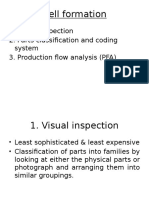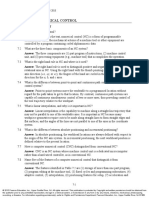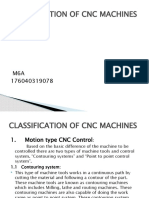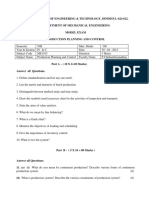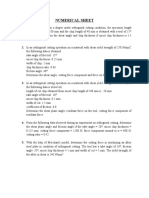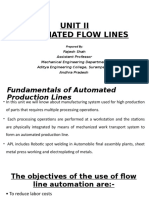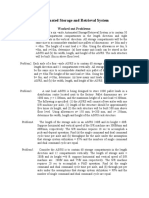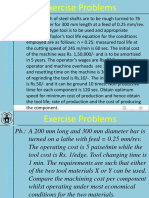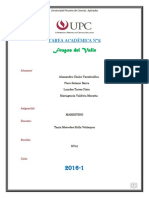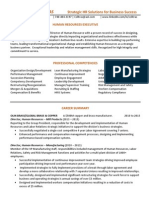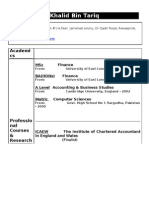MENG 452: Manufacturing Planning and Shop Loading
Tutorial # 6
Arranging Machines in GT Cell
Dr. Mohamed SALAH
�Arranging Machines in a GT Cell
(Hollier Method 2)
Four machines used to produce a
family of parts are to be arranged
into a GT cell. The From-To data From: 1
1
0
(From/To chart) for the parts
2
0
processed by the machines are
3
50
shown in the table.
4
To:
2
10
0
0
50
0
0
0
0
40
0
20
0
(a) Determine the most logical machine sequence for this data.
(b) Construct the network diagram for the data, showing where and
how many parts enter and exit the system.
(c) Compute the percentages of in-sequence moves, bypassing
moves, and backtracking moves in the solution.
�Hollier Method
Solution: (a) Hollier method 2
Step 1 & 2:
To
From
From
sums
10
40
50
50
20
70
50
50
To
sums
50
60
Sequence: 3
60
Step 3
Op. From To
170
From/To
ratio
Sequence
2
4
1
3
50
50
1.0
60
70
50
60
0.83
�Hollier Method
(b) Network diagram:
20
70
3
50
10
40
50
60
10
(c) % in-sequence moves = (50 + 40 + 50) / 170 = 0.824 = 82.4%
% bypassing moves = (20 + 10) / 170 = 0.176 = 17.6%
% backtracking moves = 0
�Performance Measures
1. Percentage of in-sequence moves
2. Percentage of bypassing moves
3. Percentage of backtracking moves
Each measure is computed by adding all of the values
representing that type of move and dividing by the total
number of moves.
It is desirable for the percentage of in-sequence moves to
be high, and for the percentage of backtracking moves to
be low.
Bypassing moves are less desirable than in-sequence moves,
but better than backtracking.
�Sheet
Determine a logical machine arrangement using
Hollier Method 2
To:
From:
1
2
3
4
0
30
10
10
5
0
40
0
0
0
0
0
25
15
0
0
�Sheet
�Sheet
2. The following table lists the weekly quantities and routings of six parts
that are being considered for cellular manufacturing in a machine shop.
Parts are identified by letters and machines are identified numerically.
For the data given, (a) develop the part-machine incidence matrix, and
(b) apply the rank order clustering technique to the part-machine
incidence matrix to identify logical part families and machine groups.
Part Weekly quantity Machine routing
A
B
C
D
E
F
50
20
75
10
12
40
326
51
54
5 4 1
326
26
�Sol. P#2
Solution: (a) See step 1. (b) See steps 1 through 3.
Step 2
A B C D E I Rank
1
1
1
5
2
2 1
1 1
1
6
3 1
1
3
3
4
1 1
6
5
5
1 1 1
4
1
6 1
1 1
2
4
Rank
2
6
3
5
1
4
Rank
A
1
1
1
E
1
1
1
F
1
1
1
1
1
4
1
1
A B C D E
1
1
1
1
1
1
1 1 1
1
1
1 1
3 8 9 6 1
1
6
Part families and machine groups:
I = (A, E, F) and (2, 6, 3)
II = (D, B, C) and (5, 1, 4)
I
1
1
10
�Sheet
3.
In Problem (2), two logical machine groups are identified by rank order
clustering. For machine group including machine 6:
(a) determine the most logical sequence of machines for this data.
(b) Construct the network diagram for the data.
(c) Compute the percentages of in-sequence moves, bypassing moves,
and backtracking moves in the solution.
Solution: (a) Hollier method applied to first machine group (machines 2, 6, 3):
Part Weekly quantity Machine routing
A
B
C
D
E
F
50
20
75
10
12
40
326
51
54
5 4 1
326
26
�Sheet
2
Step 2
From
102
102
3
To
62
62
102
Sequence:
From sums
To
sum
s
From/To
ratio
Order
102
62
1.64
102
62
164
62
(b) Network diagram
(c) % in-sequence moves = (62 + 102)/164 = 1 = 100%
% bypassing moves = 0/164 = 0 = 0%
% backtracking moves = 0/164 = 0 =0%
Note: solve the next cell (1,4,5)
�Thanks
&
Best Wishes








